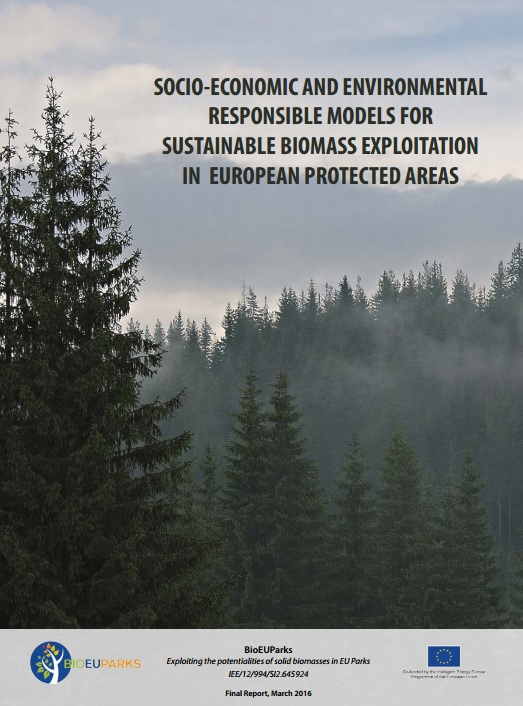Bioenergy and Protected Areas – mind the gap
Forest © Stefan Stefancik
Five European Parks (in Austria, Hungary, Slovenia, Italy and Greece) showcased how protected areas can play a leading role in finding solutions for bioenergy production at local-scale, that simultaneously ensure biodiversity conservation. The BioEUParks project, co-funded by the Intelligent Energy Europe Programme of the European Union, introduces a wealth of possibilities for Parks to boost circular bioeconomy within their regions. During 3 years, parks developed and implemented 7 models of small-scale supply chains for solid biomass, harvested from sustainably managed forests within the Parks’ area and working with the local authorities, entrepreneurs and forest owners.
Bioenergy in Europe
The success of the European Union’s renewable energy policies during the past decade is unquestionable, with an increase of over 50% share on renewable energy. Bioenergy makes up to 60% of EU’s current renewable energy use and more than 90% of the renewables in the transport sector, as biofuels.
According to the EU Staff working document (State of play on the sustainability of solid and gaseous biomass used for electricity, heating and cooling in the EU), biomass has an important role in meeting EU renewable energy targets. The possibility of storage and ability to be converted in the highest peeks of energy demand makes it an attractive source of energy. Biomass is especially important in countries where other renewable energy sources are not strong enough.
Despite the policy focus on “a sustainable use of biomass for energy purposes”, the current situation is leading to unsustainable changes in land and forest management. Earlier this year, 10 environmental NGOs have introduced relevant policy recommendations for bioenergy policy – “Pitfalls and Potentials – The role of bioenergy in the EU Climate and energy policy post 2020”, and they refer that
it is crucial to consider that bioenergy is also a source of carbon emissions and can cause a number of other undesirable environmental and social impacts, such as biodiversity loss.
María Gafo Gómez Zamalloa, from the EU DG Environment and Rural Development, referred during the BioEUParks International Conference that “it is important to remember two important numbers: 50% of Natura 2000 is forest (so it’s the most important land use in Natura 2000) and over 50% of the total renewable energy sources is bioenergy. So, how is it possible to combine these two numbers? I think that the BioEUParks project is a good example of winwin situations that could lead to fulfil these two objectives”.

Bioenergy in Protected Areas
Protected Areas overlap most of the Natura 2000 network. They are the main guardians of Europe’s nature and have already implemented (in some cases) forestry management actions, especially in areas where there was an active land use in the past. According to Petter Loffler, from the DG Environment, Unit Agriculture, Forest and Soil, “1/5 of European forests are Natura 2000 sites, and half of Natura 2000 is forests”. During the BioEUParks International Conference, Mr. Loffler referred the need to “not undertake activities that deteriorate the protection purposes or work against them (…) and yes, you can manage forests and you can extract biomass to some degree from many Natura 2000 areas forests.”
BioEUParks project borns to answer to a crucial question: how to match nature and biodiversity conservation with sustainable exploitation of woody biomass for energy purpose?
The starting point is to change perspective when looking at the bioenergy policy: nature conservation and the preservation of ecosystems and biodiversity must come first. At the same time, this choice implies a new way to see the Parks’ role, not only as the body in charge of managing natural areas, but also as a key actor in trigger new ways of local development, that can match nature conservation with social and economic growth.
The development of supply chain models were based in 4 clear characteristics:
1) Short Range from the place where the biomass is harvested to the final user, in order both to minimise the carbon emissions and ensure the quality of the biomass used for energy production;
2) Small-scale and domestic plants
Promote local investment in local plants under 1 MW of power for thermal energy production, or the investment in biomass boilers installed in public buildings (parks and municipalities’ premises, schools, gyms or other leisure time facilities) or private houses. This represents a key element for protecting both ecosystem and landscape.
3) Local engagement
The building of a biomass plant, in particular in areas of high natural value, represents a critical element. It concerns local inhabitant for the impact of the plant in terms of air and soil pollution and landscape degradation. The engagement of local inhabitants, economic actors and policy makers in the process represents the only way to build consensus. Local actors must be the first priority of the process: raising their awareness on the opportunity deriving from the sustainable exploitation of the solid biomass and agreeing with them sustainability criteria and social-economic commitment of the supply chain.
4) Sustainable Forest Management
Sustainable Forest Management and sustainable biomass exploitation criteria should be mandatory assets for the establishment of supply chains. Forest management for biomass production can also reduce fire risks, as the amount of waste being landfilled will decrease, and it opens a possibility to use subproducts of conservation activities, such as the removal of invasive species.
 The report Socio-Economic and Environmental Responsible Models for Sustainable Biomass Exploitation in European Protected Areas is a comprehensive resume of the project, covering the main challenges, results and the models developed by the 5 parks- Download it here.
The report Socio-Economic and Environmental Responsible Models for Sustainable Biomass Exploitation in European Protected Areas is a comprehensive resume of the project, covering the main challenges, results and the models developed by the 5 parks- Download it here.
For technical procedures on how to develop and implement a sustainable supply-chain download the document Steps in setting up wood biomass production chains in protected areas.
Learn more about BioEuParks mainstreaming International Conference, that took place in Brussels on the 3rd March 2016. The Conference gathered representatives of the EU Institutions, Environment NGOs and Business sector and further contributed to the debate on Bioenergy policy. Presentations and a final report can be found there.